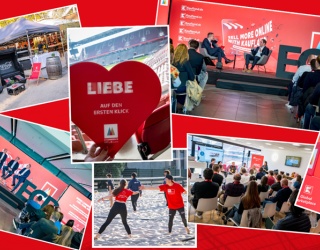They fear it might scare off men. Still, it is not just car companies that specifically seduce women to buy. Gender marketing is behind all this – the deliberate coordinated communication addressing the differences between men and women.
Women are an important buying group. They make the most purchasing decisions when it comes to groceries, they shape the design of their homes and they have more and more income available. Men don’t ask for directions and women don’t know how to park a car – there are so many biases about men and women. Some statements definitely have an element of truth. It’s great if you take this into consideration as a retailer. Who is your target group? Depending on whether that is predominately men or women, store layout and marketing should be looked over.
The traditional boundaries admittedly no longer work. Men have discovered cooking and women are interested in technology. Yet there are differences even in these instances: men like to cook with the most modern equipment, even if it rationally barely pays off – given only occasional cook-ins with friends. Women don’t buy technical gadgets as a status symbol, but because they are practical. Beauty products for men register large growth rates, whereby enormous advertising budgets only have little effect on the women’s market.
Women are important during car purchases
About a third of all registered car owners are female and the trend is rising. Since many second cars driven by women are registered to the male spouse, in reality, the percentage of women is even higher. Women are not just driving the cars; they also shape the purchasing decision. That is why manufacturers have their eye on women as a target group – but they don’t want to openly admit to it.
Once a car has a “chick car” image, it threatens to be a flop.”In fact, women are more willing to buy men’s products, but men never buy women’s products““, says Diana Jaffé, expert on gender marketing, in an iXtenso interview. She knows from experience:”Women indeed buy cars for women.“ However, those cars must not be marketed as a girl’s car.
Car companies are currently enjoying amazing sales figures on sport utility vehicles (SUVs). These off-road vehicles are becoming more and more popular with women. Americans coined the term ”hockey mom“, the well-off mother who drives her kids and their entire gear to different leisure activities in the afternoons and does her shopping. French manufacturers with their practical compact cars for the city are considered experts in understanding women. Childlike characteristics, puppy-dog eyes, in other words headlights, a ”cute“, small and round shape – all this especially appeals to a woman’s subconscious mind.
More and more women are do-it-yourselfers
DIY has long seemed to be a man’s domain, but now women are getting more self-confident. They no longer want to be dependent on male help for repairs and improvements in home and garden, says Bosch spokesperson Julia Anne Schneider in an iXtenso interview on the gender marketing topic. She says that thanks to new rechargeable batteries, power drills and hedge trimmers have become more lightweight and handy.”This appeals to men and women in the same way“. Bosch also specifically advertises in women’s magazines and uses a picture language that is meant to target women.
In the fall of 2010, Bosch had conducted a GfK survey on the topic of women and do it yourself projects. Three thousand women aged 20 and up in Germany, France and Great Britain were surveyed. More than 80 percent of women surveyed, do their own improvements in home and garden. For 43 percent of women it is especially important to be able to take care of small repairs at home themselves – this is more important to them than keeping a perfect house (41 percent). Self-confidence in their own skills is growing. Every third woman also dares to tackle more challenging projects, for instance assembling furniture, sanding or restoring it.
”The trend towards being more proactive reflects current social developments as well as the increasing number of single households or the financial independence of women“, it states in the summary of the survey results. Yet retail has still not responded to this sufficiently, criticizes Diana Jaffé. Home improvement stores are still dominated by male perception.
Men, says Jaffé, are ”product-focused“. The usual presentation on the shelves in home improvement stores makes sense for them. Women on the other hand are “people-centered“. ”They want to see the benefit a product has for them, their family or friends.“ Her tip:”Home improvement stores cannot just attract female customers by offering wallpaper workshops, but by gaining a greater understanding of how women think and what they would like to do.” She suggests ”theme-related merchandise like the items shown in lifestyle magazines“. Retail has to show what goes together.”It is not enough to put a few rolls of wallpaper next to a bucket of paint in a special display.“ The ambiance of businesses is very important to women. ”People only buy a lot where they linger around longer. Only those who feel comfortable will dig deep into their pockets.“ Conversely, men don’t feel comfortable at a drug or department store.
Marketing for special target groups
Yet gender marketing can be more than marketing for men and women. You can also differentiate within the sexes. For the past five years, Cologne has had a successful fitness studio for women – especially for Muslim women. At “Hayat“
women from Turkey or North Africa exercise. German women also join in. Muslim women can also exercise without wearing a veil and there are cloths available to wrap around for the sauna. Founder Emine Aydemir also addresses women who are otherwise isolated at home. On TV (in parts the same video material) she likes to explain her business idea. Admittedly, the market niche is small and only big enough in certain city neighborhoods. The DSSV (German Sports Studio Association) however, doesn’t know of any comparable business.
In Hamburg, a hair salon specializes in men as its target audience – even though women visit hair salons far more often. The salon is called ”Whistler“ and aims to be more of a lounge rather than a salon. Its name is reminiscent of the “Hustler” US men’s magazine name. In this instance, operators also gave thought as to whom they want their target audience to be and what men miss in traditional stores. The women cut hair wearing short skirts, “Playboy” magazine replaces “People” magazine here and widescreen TVs show sportscasts.
General Motors wanted to boosts sales of its Volt with an ad in a gay magazine. The advertisement for 750 dollars was an enormous success. The target audience has a strong network and people loved to post the campaign. The Internet also helps out in the mass market when it comes to the question of what men and women want to buy. In forums and blogs, male and female users willingly share tips – a great source for manufacturers and retailers.
René Schellbach, iXtenso.com
Link tip
Funny video: The perfect chick car – only 11 seconds long










